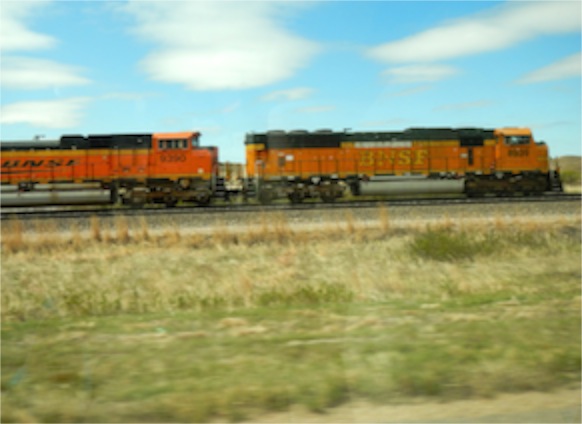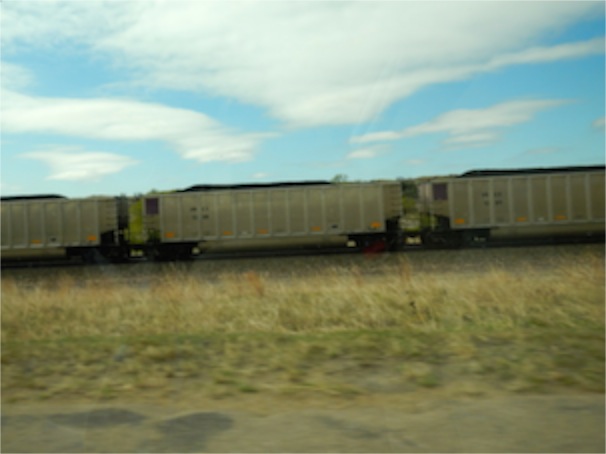Road Trip
10/05/14 03:42
I am writing from Hastings Nebraska this morning. It takes about 7 1/2 hours to drive from Rapid City to Hastings, so I left early yesterday to drive down here. I am teaching a seminar down here. Eight hours of classroom time this weekend, a month of assignments and online contact and then another weekend with eight hours of lectures and classroom experiences in June. The course is part of Cotner College’s Education for Lay Ministry program (ELM). This is the fifth time I have taught a basic Christian Education class for ELM students. I vary the lectures quite a bit from year to year, so the course remains fresh for me. The field of Christian Faith Formation is a rapidly changing area of the church’s life and my keeping up and ready to teach the course is a good investment of my time for the congregation I serve as well as for the students, most of whom will serve congregations in Nebraska.
The road trip yesterday was good for clearing my mind. From time to time I enjoy a good road trip. It has been quite a while since I have driven across the Rosebud Reservation. I get to Pine Ridge and Cheyenne River on a regular basis, but they aren’t the only indigenous communities in our state. It is worth the trip to check up on things in other places. Although Nebraska now only has only small reservations for the Santee, Omaha and Winnebago tribes and all are in the Eastern Part of the state, the land once was home to Cheyenne, Lakota, Arapaho, Ponca, Yankton, Pawnee and other tribes.
It was good to drive through the Sandhill country as well. There is plenty of water this spring and the country was remarkably green. The great crane migration has already passed and the swans have moved north as well, but the country is beautiful and I had a wonderful spring day for my drive.
 One can’t drive across central Nebraska without being aware of the great coal trains that are continually traveling across the state. The mainline across the center of the state is operated by the Burlington, Northern, and Santa Fe. The trains are loaded at the Thunder Basin Coal Mine near Wright, Wyoming. It is the largest surface coal mine in the world with 6 draglines operating as well as dozens of big shovels and nearly 150 haul trucks bringing to coal to where it is loaded onto trains that are continually in motion as they load. A typical coal train is 5 locomotives and 115 hopper cars and stretches more than a mile. The mine loads over 30 miles of coal trains every day. For all of this decade they have mined over 100,000,000 tons of coal each year, which means that about 4 tons of coal is extracted per second from the mine. The coal goes to 25 states and the permitting process is underway for a giant coal loading facility to be located in Oregon or Washington to transfer coal from trains to ocean going ships for export to Japan and China.
One can’t drive across central Nebraska without being aware of the great coal trains that are continually traveling across the state. The mainline across the center of the state is operated by the Burlington, Northern, and Santa Fe. The trains are loaded at the Thunder Basin Coal Mine near Wright, Wyoming. It is the largest surface coal mine in the world with 6 draglines operating as well as dozens of big shovels and nearly 150 haul trucks bringing to coal to where it is loaded onto trains that are continually in motion as they load. A typical coal train is 5 locomotives and 115 hopper cars and stretches more than a mile. The mine loads over 30 miles of coal trains every day. For all of this decade they have mined over 100,000,000 tons of coal each year, which means that about 4 tons of coal is extracted per second from the mine. The coal goes to 25 states and the permitting process is underway for a giant coal loading facility to be located in Oregon or Washington to transfer coal from trains to ocean going ships for export to Japan and China.
Driving across central Nebraska the scale and scope of the operation is evident as I passed train after train. The eastbound trains were full, the westbound trains were returning empty. Trains are crossing the state day and night to provide coal to power plants to provide electricity to cities and towns.
 Trains are a relatively efficient way to move heavy loads. A train can move a ton of freight nearly 450 miles per each gallon of diesel consumed. Still, it takes tens of thousands of gallons of diesel to transport coal across several states to deliver it to the power plants.
Trains are a relatively efficient way to move heavy loads. A train can move a ton of freight nearly 450 miles per each gallon of diesel consumed. Still, it takes tens of thousands of gallons of diesel to transport coal across several states to deliver it to the power plants.
Our desire for more and more electricity results in consuming even more fuel than just what is required for generation, because we also have to transport the fuel to the generators.
You might think that the most efficient use of the limited energy resources we have is to produce the electricity as close as possible to the mine site, thus decreasing the amount of fuel required for transport and the not insignificant amount of coal that is lost during transport. Coal is shipped in open top carriages and the coal dust blowing off the top of the cars means that the amount received by the power plant is less than the amount shipped from the mine. However, the trend seems to be going in the opposite direction. Transporting electricity through high voltage lines is not completely efficient. It seems that significant amounts of electrify are wasted through the process of transmission. Because the United States lacks a truly smart grid, the electricity is not always where it is needed. Thus power plants tend to be located nearer to the places that use the electricity. Mines tend to be in rural and isolated locations. In addition to that factor, the fuel used to generate electricity is changing in the United States. Because of air quality issues, it is unlikely that the United States will see very many new coal fired generators constructed. Natural gas is the preferred alternative for power generation. This is not the case in China and Japan. After the Fukushima disaster in Japan, that country is returning to coal as a fuel for power generation and the rapidly increasing demand for power in China combines with decreased west to east shipping costs to make coal an attractive fuel in China. The high number of consumer goods that are manufactured in China and consumed in the United States means that there are thousands of empty shipping containers in the US that have to be returned to China. Filling those containers decreases shipping costs.
The dynamics of world electricity consumption and distribution are far beyond the scope of my expertise, but the continuing flow of coal across the State of Nebraska occupied my thinking as I drove yesterday. The distraction of thinking about something other than the day to day business of the church provided a much-needed break for me.
My lectures went well last night and we have six hours of class and I have eight hours of driving on the agenda for today. Like the coal trains, I’ll be returning somewhat emptied, ready to be filled tomorrow with the joy of worshiping with my home congregation.
The road trip yesterday was good for clearing my mind. From time to time I enjoy a good road trip. It has been quite a while since I have driven across the Rosebud Reservation. I get to Pine Ridge and Cheyenne River on a regular basis, but they aren’t the only indigenous communities in our state. It is worth the trip to check up on things in other places. Although Nebraska now only has only small reservations for the Santee, Omaha and Winnebago tribes and all are in the Eastern Part of the state, the land once was home to Cheyenne, Lakota, Arapaho, Ponca, Yankton, Pawnee and other tribes.
It was good to drive through the Sandhill country as well. There is plenty of water this spring and the country was remarkably green. The great crane migration has already passed and the swans have moved north as well, but the country is beautiful and I had a wonderful spring day for my drive.

Driving across central Nebraska the scale and scope of the operation is evident as I passed train after train. The eastbound trains were full, the westbound trains were returning empty. Trains are crossing the state day and night to provide coal to power plants to provide electricity to cities and towns.

Our desire for more and more electricity results in consuming even more fuel than just what is required for generation, because we also have to transport the fuel to the generators.
You might think that the most efficient use of the limited energy resources we have is to produce the electricity as close as possible to the mine site, thus decreasing the amount of fuel required for transport and the not insignificant amount of coal that is lost during transport. Coal is shipped in open top carriages and the coal dust blowing off the top of the cars means that the amount received by the power plant is less than the amount shipped from the mine. However, the trend seems to be going in the opposite direction. Transporting electricity through high voltage lines is not completely efficient. It seems that significant amounts of electrify are wasted through the process of transmission. Because the United States lacks a truly smart grid, the electricity is not always where it is needed. Thus power plants tend to be located nearer to the places that use the electricity. Mines tend to be in rural and isolated locations. In addition to that factor, the fuel used to generate electricity is changing in the United States. Because of air quality issues, it is unlikely that the United States will see very many new coal fired generators constructed. Natural gas is the preferred alternative for power generation. This is not the case in China and Japan. After the Fukushima disaster in Japan, that country is returning to coal as a fuel for power generation and the rapidly increasing demand for power in China combines with decreased west to east shipping costs to make coal an attractive fuel in China. The high number of consumer goods that are manufactured in China and consumed in the United States means that there are thousands of empty shipping containers in the US that have to be returned to China. Filling those containers decreases shipping costs.
The dynamics of world electricity consumption and distribution are far beyond the scope of my expertise, but the continuing flow of coal across the State of Nebraska occupied my thinking as I drove yesterday. The distraction of thinking about something other than the day to day business of the church provided a much-needed break for me.
My lectures went well last night and we have six hours of class and I have eight hours of driving on the agenda for today. Like the coal trains, I’ll be returning somewhat emptied, ready to be filled tomorrow with the joy of worshiping with my home congregation.